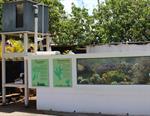
Study Aquaculture
- Start a new career in aquaculture
- Add a new skill to your CV
- Start your own business in aquaculture
- Become more self-sufficient
Learn About Fish and Crustacean Farming. Start now or at any time to suit you.
- Learn to grow freshwater fishes, crayfish, etc
- Discover a whole new way of farming; for greater sustainability and diversification on the farm
- Broaden your knowledge and skills, exploring and extending opportunities for business and career
With the current global decline in wild fish stocks, aquaculture has become a rapidly growing business, this course focuses on the set up and cultivation of fish in a commercial enterprise while looking in depth at several commonly farmed species including: trout, barramundi, bass and marrons, yabbies and red claw.
Lesson Structure
There are 10 lessons in this course:
-
Introduction
-
Advantages and disadvantages, references, applications and potential.
-
Production Systems
-
Defining and comparing extensive and intensive production.
-
Species to Grow
-
Trout, Mullet, Marron, Bass, Barramundi, Yabbies, Red Claw & more.
-
Trout
-
Trout & water, determining water flow, temperature, dissolved oxygen, stocking rates, spawning, checking fish & stripping technique, fertilization and hatching.
-
Barramundi
-
Industry perspective, breeding & growth rates, fry maintenance, after care, pod rearing, costs.
-
Bass
-
Australian and other species
-
Marron, Red Claw and Yabbies
-
Habitat requirements, water, temperature, pH, salinity, pond size, organic loading, water clarity, feeding, harvesting.
-
Setting up a Farm
-
Land and water needs, pond construction, cages, biological filtration, clearing turbid water, improving quality, protecting stock.
-
Foods & Feeding
-
Pellets, live food, fishmeal, lights, importance of food.
-
Harvesting
-
Seine nets, gill nets, traps, flyke trap, long lines, marketing produce.
Aims
-
To discuss the nature and scope of freshwater aquaculture.
-
Explain different aquaculture production systems.
-
Compare the cultural requirements of different types of fish and choose the most suitable for aquaculture in your region.
-
Explain the commercial production of trout.
-
Explain the commercial production of barramundi.
-
Explain the commercial production of bass.
-
Explain cultural practices for freshwater crayfish.
-
Develop informed management decisions for establishing an aquaculture enterprise.
-
Explain methods, including feeding and harvesting, used to manage freshwater animal populations.
-
Describe harvesting and marketing in an aquaculture enterprise.
 Why Farm Fish?
Why Farm Fish?
Aquaculture can increase efficiencies and productivity on farms, giving increased return from under utilized resources (eg. farm dams, space, etc). Such resources include the use of crop wastes, marginal land unsuitable for crops or pastures, effluent water, and such like. Fish production can use many of these efficiently. A prime example is the use of piggery and poultry wastes for fertilization of fish ponds.
Most farms have some form of water storage necessary for the watering of animals and the irrigation of pastures and feed crops. The many hectares of water that stand idle all over our country can be used for fish production while it is waiting to be used for irrigation. This allows the water to be used more efficiently by producing fish in it before using it for irrigation. The integration of fish farming in an established farming system can be beneficial to the latter. The organic enrichment of the water will benefit any crops being irrigated with this water.
There are certain advantages to aquaculture:
- It is known to produce more animal protein per hectare than most other kinds of livestock farming.
- It can often make good use of marginal land which is unsuitable for other forms of agriculture.
- Fish contain a greater percentage of edible flesh than most other farmable animals.
- Livestock live off food generally inedible to man (i.e. grazing and natural pasture).
- They also require less feed to produce this flesh. The feed conversion efficiency is partly due to most fish being cold blooded and not having to expend energy to keep warm or cool. This energy remains stored as flesh and fat. Also, the buoyancy of the water habitat in which fish live means they have to use less energy for movement and support than land animals.
There are also certain disadvantages:
- Commercial production of fish requires a high quality, high protein feed. The proportion of protein in most livestock diets is lower than that required for fish, and many are adapted to extract the protein from amino acids in the plants they feed on.
- Setting up an intensive fish farm is far more expensive than enclosing land with conventional or electric fencing and establishing grazing for livestock.
- The constant nature of aquatic environments means that fish are prone to a wide variety of sicknesses, diseases, parasites and predators. They can tolerate only small changes in their environment and these must not be too sudden or drastic.
- Aquaculture requires a clean supply of water, free of excess nutrients or pollutants.
The advantages certainly outweigh the disadvantages under most circumstances. It is up to each individual farmer to determine if farming with fish can fit into his existing farming facilities and plans and if it will be profitable for him to add fish to his farming operation, or change completely to fish production.
Any questions?
With global food shortages and the importance of sustainability, aquaculture is an important way of producing food. This course is suitable for the complete beginner or experienced people who would like to expand their knowledge into aquaculture. This course will provide you with a thorough and detailed insight into aquaculture.
Please ask if you do have any questions. Our Aquaculture tutors are more than happy to help.
